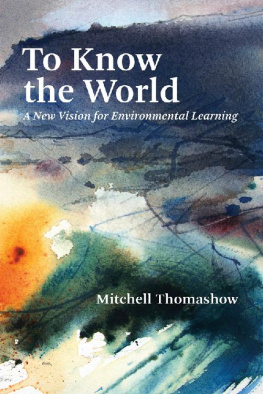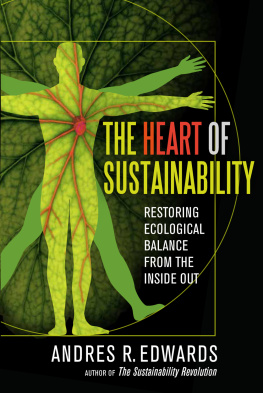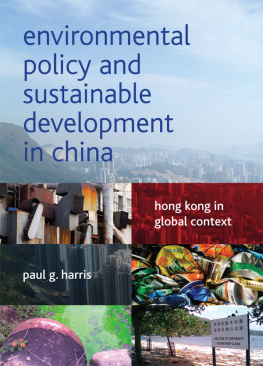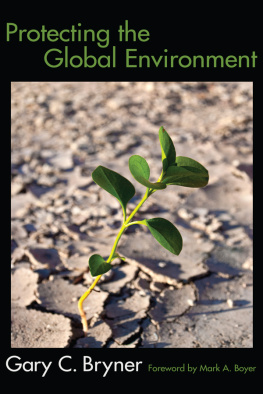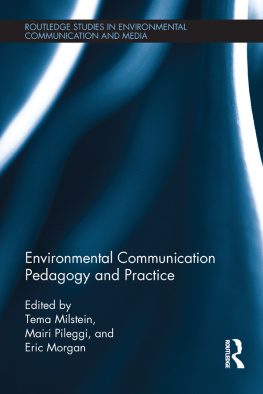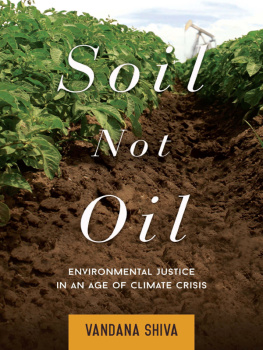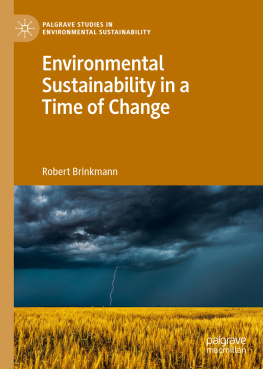
To Know the World
To Know the World
A New Vision for Environmental Learning
Mitchell Thomashow
The MIT Press
Cambridge, Massachusetts
London, England
2020 Massachusetts Institute of Technology
All rights reserved. No part of this book may be reproduced in any form by any electronic or mechanical means (including photocopying, recording, or information storage and retrieval) without permission in writing from the publisher.
This book was set in Sabon LT Std by New Best-set Typesetters Ltd.
Library of Congress Cataloging-in-Publication Data
Names: Thomashow, Mitchell, author.
Title: To know the world : a new vision for environmental learning / Mitchell Thomashow.
Description: Cambridge, Massachusetts : The MIT Press, 2020. | Includes bibliographical references and index.
Identifiers: LCCN 2020002975 | ISBN 9780262539821 (paperback)
Subjects: LCSH: Environmental education. | Human ecology. | NatureEffect of human beings on.
Classification: LCC GE70 .T53 2020 | DDC 363.70071dc23
LC record available at https://lccn.loc.gov/2020002975
10 9 8 7 6 5 4 3 2 1
d_r0
What is the single best thing a person can do for tomorrows world?
Richard Powers, The Overstory
Contents
Acknowledgments
Where would we be without our friends, peers, and colleagues? My personal and professional life is, above all, a shared experience. Resonating insights reverberate through all dimensions of a life. Where do insights come from? What prompts inspiration? A kind word, an open ear, an evocative passage, a ray of sunshine, a soft wind on a cloudy day. I perceive myself as one being in an intricate network of relations, aspiring to learn, attracted to people who are striving to know the world, promote environmental learning, and contribute to community well-being. These networks, both visible and unseen, provide support for the book-writing process. The ideas in To Know the World are collective interpretations, massaged through many minds, and cultivated over many years. I couldnt possibly thank all the people who offered support, encouragement, and reciprocity, in ways both direct and intangible. Our friends and relations plant so many seeds in the course of a lifetime, and you never know when they will sprout.
Ive shared various sections of this manuscript with the following people, all of whom provided kind encouragement and caring critique. Thanks to Simmons Buntin, Alison Deming, Andrea Hedley, Stephanie Kaza, David Lukas, Kathleen Dean Moore, Eric Poettschacher, Christian Rappich, Scott Slovic, Mary Evelyn Tucker, and Tyler Volk.
My good friend, the late Robert D. Kahn, supplied much encouragement along the way.
Thanks to Marina Alberti, Jennifer Bender, Michel Boudrias, Claudia Frere-Anderson, Heather Henriksen, Mary Leou, Joan Raichlin, Grace Wang, and Thomas Webler for allowing me to present ideas to their classes, organizations, and/or staff.
During the writing process, I taught graduate students in the Environmental Education and Communication masters program at Royal Roads University, Urban Environmental Education masters program at Antioch University Seattle, and undergraduates at Northeastern University. These students worked with the material in its earlier forms. Their discussions and responses were invaluable.
Howard Drossman and Margot Kelley read the entire manuscript, and then sent me comprehensive comments, all of which were pertinent and constructive. They were amazingly helpful. Additional thanks to Margot for suggesting the title.
The MIT Press reviewers provided excellent comments. Ive done my best to incorporate changes that respond to their fine suggestions.
A thousand thanks to Beth Clevenger at the MIT Press. Her support, wisdom, patience, and common sense were brilliant. What a pleasure to work with someone who truly understands what youre trying to accomplish!
Cindy Thomashow, my spouse and life partner, listened to every word, often several times in a day, allowing me to interrupt whatever she was doing (within reason), and provided every conceivable means of support, caring critique, and love.
I
Why Environmental Learning Matters
1
The Past and Future of Environmental Learning
Now More Than Ever
In the early decades of the twenty-first century, the mainstream media continuously hyped breaking news, but the week of September 20, 2019, was truly momentous. Six million climate activists, mainly young people and their adult supporters, from 163 countries, staged over 2,000 eventsincluding mass rallies, school walkouts, and street demonstrations. Although an important focal point was Greta Thunbergs emotional and riveting UN speech, her story was a symbolic narrative encompassing the dreams, aspirations, and fears of millions of global youths from a great diversity of geographic and cultural locations.
That week, a study published in Science magazine, Decline of the North American Avifauna, claimed that since 1970, the number of North American birds declined by 2.9 billiona drop of 29 percent. The story received widespread mainstream media attention. The New York Times (September 25) reported on the most recent Intergovernmental Panel on Climate Change study warning of dire threats to the worlds oceans. Still on the newsstands, the August issue of National Geographic, World on the Move, was devoted to global migration with the subheading Seas Rise, Crops Wither, Wars Erupt. Humankind Again Seeks Shelter in Another Place. The September issue, The Arctic Is Heating Up, included the additional subheading on its cover: Thawing Tundra Will Speed Up Global Warming.
For people who have been following environmental issues since the 1960s, as I have, these are stories were accustomed to. Over fifty years later, the direct, tangible impact of climate change, threats to biodiversity, and species extinction are reaching a new thresholdsomething we surely anticipated. Whats different is that the impacts now are so tangible, dramatically impacting the lives of just about everyone who lives on the planet. These events are no longer the supposed special interest of environmental advocates. They are the source of profound human and more-than-human suffering. The young climate activists were born into a world where they worry that their future is limited, their opportunities are diminished, and the earth is in danger. They are fed up with the inaction of global leaders. And they have had enough.
Despite the best efforts of environmental education to deepen awareness of these questions, we have so much more work to do, and much less time to do it. We must embrace the urgency of this ecological planetary emergency. This is a book about environmental learninghow we broaden the scope of our educational efforts, and make connections between the seminal issues of our time, such as migration, race, inequity, climate justice, and democracyand our understanding of the biosphere. My impression is that climate activists understand these relationships because they live them every day. Our educational work is how to deepen that understanding, use it to inspire widespread action, further clarify the connections, and weave the individual narratives of agency and action into a collective global narrative of constructive change.
I am proposing that we revitalize, revisit, and reinvigorate how we think about our residency on this planet, and am interested in educational approaches for doing so. For all the accomplishments of environmental education (and there have been many), we have not been able to stem the inexorable decline of global ecosystems. Indeed, environmental education is often trivialized, diminished, marginalized, and stereotyped as the province of tree huggers. Thats why I use the term environmental learning to suggest that our relationship to the biosphere must be front and center in all aspects of our daily experience. This book provides the reasoning, narratives, and approaches for doing exactly that.
Next page
